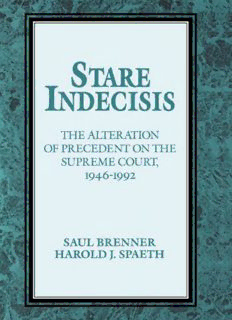
Stare Indecisis: The Alteration of Precedent on the Supreme Court, 1946–1992 PDF
Preview Stare Indecisis: The Alteration of Precedent on the Supreme Court, 1946–1992
Although the concept of precedent is basic to the operation of the legal system, there has not yet been a full-length empirical study of why U.S. Supreme Court justices have chosen to alter precedent. This book attempts to fill this gap by analyzing those decisions of the Vinson, Warren, and Burger Courts, as well as the first six terms of the Rehnquist Court- a span of 47 years (1946-1992) - that formally altered precedent. The authors summarize previous studies of precedent and the Court, assess the conference voting of justices, and compile a list of overruling and overruled cases. Additionally, the authors draw a distinction between personal and institutional stare decisis. By using the attitudinal model of Supreme Court decision making, which is normally seen as antithetical to the legal model of voting, the authors find that it is the individual justices' ideologies which explain their voting behavior. STARE INDECISIS STARE INDECISIS THE ALTERATION OF PRECEDENT ON THE SUPREME COURT, 1946-1992 SAUL BRENNER University of North Carolina, Charlotte HAROLD J. SPAETH Michigan State University CAMBRIDGE UNIVERSITY PRESS Published by the Press Syndicate of the University of Cambridge The Pitt Building, Trumpington Street, Cambridge CB2 1RP 40 West 20th Street, New York, NY 10011-4211, USA 10 Stamford Road, Oakleigh, Melbourne 3166, Australia © Cambridge University Press 1995 First published 1995 Library of Congress Cataloging-in-Publication Data Brenner, Saul, 1932- Stare indecisis : the alteration of precedent on the Supreme Court, 1946-1992 / Saul Brenner, Harold J. Spaeth. p. cm. Includes index. ISBN 0-521-45188-4 1. Stare decisis - United States. 2. Judicial review - United States. 3. Judges - United States - Attitudes. I. Spaeth, Harold J. KF429.S68 1994 347.73'12-dc20 [347.30712] 94-33753 CIP A catalog record for this book is available from the British Library. ISBN 0-521-45188-4 Hardback Transferred to digital printing 2003 For Martha - for sharing my joys and pains For David, Daniel, and my sister Deena - for the great pleasure you gave me seeing you grow from birth to adulthood Saul Brenner For Mary Kay - who is truly Number 1, except in Latin Harold J. Spaeth Contents List of tables and figure page ix Preface xi 1 INTRODUCTION 1 Justification for stare decisis 2 Stare decisis applied: Payne v. Tennessee 6 Conclusion 9 2 A SURVEY OF THE EMPIRICAL LITERATURE 10 Ulmer's study 10 Schmidhauser's study 13 Danelski's study 15 Banks's study 16 The Epstein et al. study 16 3 A LIST OF CASES 18 Criteria for determining the alteration of precedent 19 Criteria for ascertaining the salience of the overruled and overruling decisions 23 Precedents altered by the Court 26 Conclusion 28 4 SOME CHARACTERISTICS OF THE OVERRULING AND OVERRULED CASES 29 The ages of the overruled precedents 29 The importance of the overruling and overruled cases 33 The bases on which the Court alters precedent 35 Opinion assignment in the overruling cases 37 The number and kinds of opinions in the overruling and overruled cases 43 Coalition size in the overruling and overruled cases 45 Conclusion 47 5 THE CONFERENCE VOTES 49 The vote to grant or deny cert 50
Description: